- Identification
- Range
- Habitat
- Harvest
- Uses
- Where else can you find pawpaws?
- TL;DR: Pawpaws at a glance
The wild pawpaw. Asimina triloba. Largest North American fruit. One with as many aliases as Billy the Kid — Bandango, Indiana Banana, Poor Man’s Banana, or simply Paw Paw.
An indescribable cross between banana, mango, pineapple, and whatever fruitarian delicacy you might not be able to imagine.
The thing forager dreams are made of.
Pawpaws rank at the top of my list of favorite native-to-the-United States fruits.
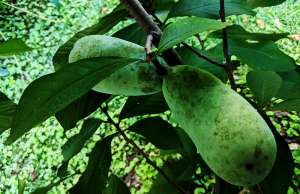
Pawpaws on the branch. Photo by Fuz Sanderson
Identification
Fruit
Depending on region, pawpaws are ready from the end of August through October and the season lasts about 30 days.
In our region, they’re ripe in August.
Pawpaws are normally three to six inches long, sort of kidney-shaped, and they grow in clusters like bananas.
They start off green (often with black spots) and turn yellow, brown, and then purplish black.
They get super-soft and fall off the tree when they’re fully ripe but they can be shaken off when they’re close to being ripe.
Pawpaws have a distinct floral or fruity smell which alludes to the sweet flesh that lies beneath the skin.
The skin, which is not eaten, is thin but tough and bruises easily — it’s a quality that usually gets blamed for the pawpaw’s failure to achieve commercial status in modern markets.
The light yellow flesh inside is mushy and tends to ooze out of the skin when you cut a pawpaw open.
It’s not a fruit that you just take a bite of.
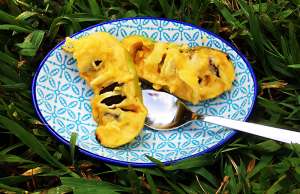
Pawpaws sometimes have a slight bitterness about them that’s caused by a thin layer of phenolic compounds that lies between the skin and the sweet flesh.
Simply scrape away that layer to avoid the bitterness.
The fruit is also loaded with largish dark brown, toxic seeds that get in the way of spooning out the good stuff.
I believe the best way to eat a pawpaw is to just suck it out of the skin. Or scoop it all into a bowl and then separate the seeds.
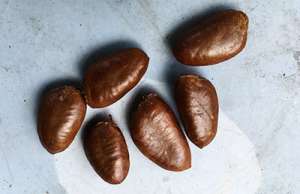
The flavor reportedly varies from tree to tree and even fruit to fruit. It’s been compared with bananas, mangos, pineapple, and any combination thereof.
The texture is somewhat like a mango without all of the stringiness, often referred to as “custardy”.
A bit of caution, though: Pawpaws make some people nauseated after eating them.
Some have reported that illness ensued immediately, while others say it took eating a second pawpaw some time later.
In Andrew Moore’s book Pawpaw: In Search of America’s Forgotten Fruit, Jim Davis of Deep Run Pawpaw Orchard says that pawpaws can be emetic when underripe or overripe.
Maybe all the folks who get sick are just victims of bad timing? Either way, as with any wild food you’ve not eaten before, maybe just try a little at first.
Trees
Pawpaw trees generally don’t get more than 40 feet or so tall and they commonly appear as small shrubs.
Asimina triloba is the most prominent species, but there are a few others that occur in various subregions of the pawpaw’s range. Some are dwarf versions, growing only four or five feet high (more species listed below).
The pawpaw spreads primarily by sending out runners or suckers, often forming dense thickets of clones that are barren because they lack the genetic diversity necessary to produce fruit.
I had a friend who spoke of the pawpaws that took over his yard. He finally just took them all out. It's something I have a hard time imagining.
Leaves
The leaves are alternate, smooth, and wider at the tip. They can be up to 20 inches long.
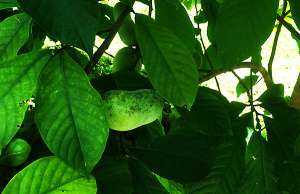
Flowers
Pawpaw flowers appear in early spring as beautiful blossoms that smell disgusting.
They’re pollinated by carrion flies which are attracted by the distinct scent of rotting flesh.
Some pawpaw growers even hang chicken skins and other foul (get it?) attractants in their orchards to draw in the pollinators necessary for setting fruit.
The flowers are about two inches across and have three outer petals and three smaller inner petals — they can be white, purple, or maroon.
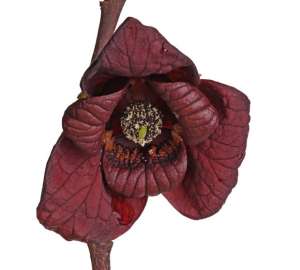
Range
Pawpaws grow naturally as far west as Texas, north to Canada, and throughout most of the midwestern and eastern U.S.
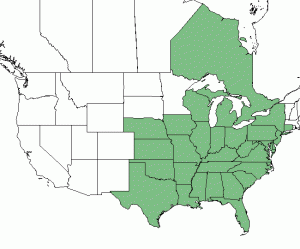
Habitat
Pawpaws thrive in wettish areas like river bottoms but, according to the National Park Service, their range has expanded into higher and drier forests in recent years.
They attribute the spread partly to deer foraging habits.
The theory is that, since deer populations are unnaturally high in many areas and since they don’t like pawpaw leaves, the deer are more prone to browse the tastier plants that grow alongside pawpaws, like spicebush and maple.
In doing so, deer eliminate the competition and make way for pawpaws to effortlessly move into new areas.
Throughout the pawpaw’s range, it normally occurs as an understory tree, hidden from view in the shade of taller trees, which is one reason the pawpaw is not such a well-known fruit even where it’s native.
Like most fruit trees, though, pawpaws are much more productive in the sun, while the naturally growing trees in the shade of forest tend to be less likely to bear fruit.
That, coupled with the fact that so many pawpaw thickets are essentially groups of non-fruiting clones sharing the same DNA, pawpaw fruit can be really hard to find in the forest.
But in some regions, like Florida and south Georgia, pawpaws are commonly found growing in full sun along the edges of pastures and fields, thriving in drier, well-drained dirt.
These trees are more likely to bear fruit.
Harvest
The trick to getting pawpaws is timing.
Once you’ve located a productive tree, you’ll need to be vigilant about checking it for ripe fruit.
You’re competing with raccoons, possums, squirrels, and any manner of fruit eating animals that share habitat with pawpaws, and once the fruit is ripe, it falls off the tree.
Like avocados, it’s a game of “wait, wait, wait, too late”. It’s rock-hard until it’s not and then it departs the tree with a disastrous thud.
Uses
I would say the most common use for pawpaws is just gorging on them right from the tree.
Desserts like ice cream and pudding are great for pawpaws.
Basically, anything you can do with persimmons, you can do with pawpaws.
Pawpaw bread is another popular way to eat the fuit.
And apparently feremented pawpaws in the forms of beer, cyser, mead, and brandy were favored by our founding fathers.
Stay away from pawpaw fruit leather, though. For some reason, it causes severe nausea, even though some Native American tribes traditionally used dried pawpaw to make pemmican.
They seemed to have figured out something in the processsing that made them safe to eat.
Please let me know if you figure that out or know something about it.
Where to buy
In season, you might be able to find pawpaws at a farmers market.
I was lucky enough to find a local farm this season that sold pawpaws they harvested from wild trees on their property.
They also sold “pawpcicles” made by a local popcicle company called Locopops (or check them out on Facebook).
You can also order pawpaws fresh or frozen online but expect to pay hefty shipping for the fresh fruit.
Here’s one vendor: https://www.earthy.com/
At a Glance
Latin and common names:
- Asimina triloba (pawpaw, paw paw, bandango, Indian banana, poor man’s banana, Hoosier banana, custard apple)
- Asimina incana (woolly pawpaw)
- Asimina longifolia (slimleaf pawpaw)
- Asimina obovata (bigflower pawpaw)
- Asimina parviflora (smallflower pawpaw or dwarf pawpaw)
- Asimina tetramera (four-petal pawpaw)
Leaves: 5 - 20” long, smooth, widest at the tip.
Fruit: End of August through mid-October, depending on region, 2-4 inches long, oblong or kidney-shaped, growing in clusters like bananas.
Starts off green, then progresses to yellow, brown, and purplish-black.
The colors indicate various degrees of ripeness, but green to yellow seems to be when most prefer to eat it.
The soft flesh is yellow with a custard-like texture and a flavor that is described as a combination of mango, banana, and/or pineapple.
The fruit contains several large, toxic brown seeds.
Flowers: 2 inches across, 3 outer petals, 3 smaller inner petals.
They bloom in spring and can be white, purple, or maroon.
Tree: A few feet to 40 feet tall.
Habitat: Rich, wet, shady areas like river bottoms but can also occur in well-drained soil in full-sun.